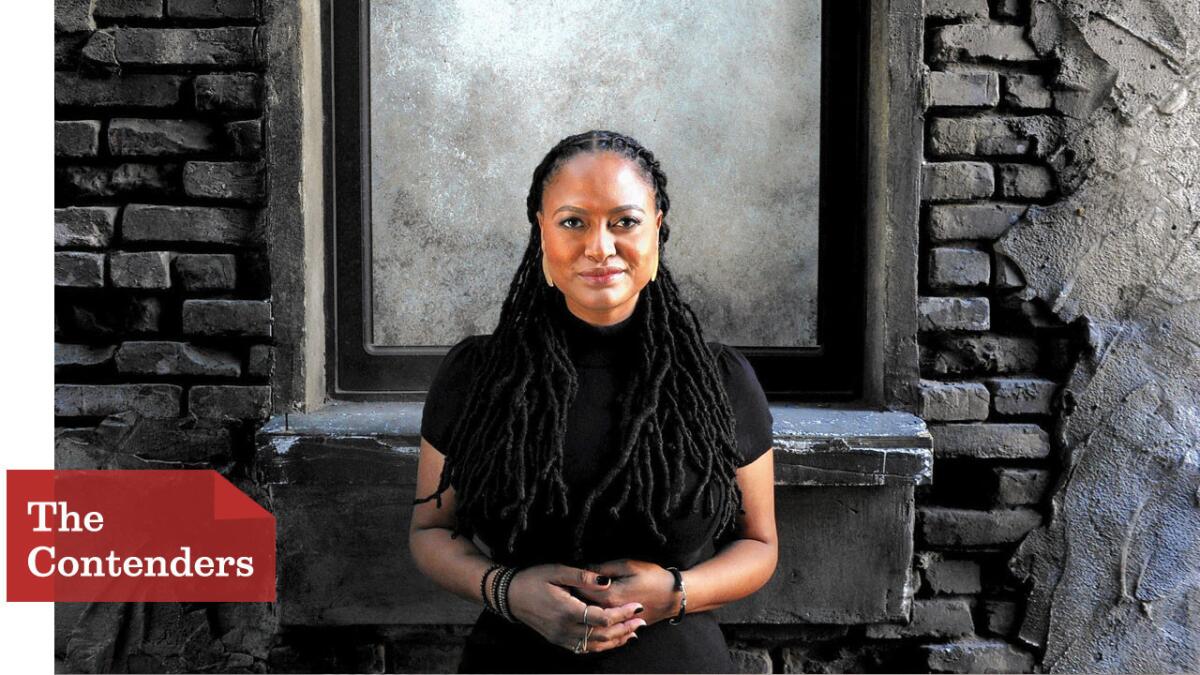The Envelope: Director Ava DuVernay populates ‘Selma’ with real people and events

Director Ava DuVernay is finalizing the sound mix on the last few minutes of “Selma” on the Saturday night before Thanksgiving, roughly a month before the movie’s Christmas Day opening. On a huge screen, actor David Oyelowo portrays Martin Luther King Jr., standing before the Alabama Statehouse at the finish line of an embattled and historic 1965 march for voting rights: “We are here, and we ain’t gonna let nobody turn us around!” he proclaims in stirring, majestic tones. “There’s a new energy that’s stronger than the strongest opposition.”
DuVernay, wearing black-framed glasses, watches from behind a mixing console, chin tilted up. “Spike the music on the corner, and then cross-fade,” she directs her team. When the crew breaks for a meal, she settles in to talk about the Paramount film, which premiered (unfinished) at the AFI Film Festival to exceptional reviews. The moment is bittersweet, she allows: She’s about to relinquish the locked master print and find herself suddenly jobless, almost a year after she began work on the $20-million project, her first studio movie and third feature.
“This is it, and it’s emotional,” she says. “I’ll probably have separation anxiety tomorrow.”
One of the reasons this movie feels fresh is its frankness about the tactics required to make civil rights progress. We see King as a tough-minded strategist who chose Selma, Ala., as a staging ground for nonviolent protest precisely because of the potential for brutal opposition. Why did you want to show this?
We were really trying to deconstruct the mythology of King and the iconography of a leader. What’s interesting to me is how the wheels turn and what happens in the meeting or the war room before the part that’s presented to the public. We already know that he’s a great orator. I’m interested in showing what we don’t know, including how he was with his wife, or that he liked to have a Newport [cigarette] now and then or joke with his friends. I’m always trying to build a man instead of a statue.
Did you ever exaggerate the violence? Like when King and his party register at the Hotel Albert in Selma and that man walks right up and punches him in the face?
No, that’s real. He was testing whether Selma would be a good place to stage this drama when a guy from the White Citizens’ Council hit him right in the face. I stayed as close to the truth of all that as possible. The sheriffs really did use whips and horses on that bridge on Bloody Sunday. They really followed Jimmy Lee Jackson into that cafe and shot him. That explosion in the church took place in Birmingham, but it was a catalyst. Really, these people lived in a terrorist state, where anything could blow up or they could be randomly assaulted, humiliated or murdered.
This movie has some unusual rhythms — it takes its time with the more intimate scenes and subverts expectations in some of the bigger historical moments. What were you going for?
I’m a person who doesn’t really like black historical dramas, so I was constantly challenging the tropes you see in these movies, from the way it was lit and cut to the way people behave in the scenes to the way the narrative unfolds. I focused on bringing in more of the people of Selma, to show the blossoming that happened there during this period, and creating memorable characters that you wanted to follow, who just happened to be these icons. For me, the most important scene between Martin and Coretta [Carmen Ejogo] was the first one, where she’s helping him with his ascot and they have a little daydream about what they could do if they weren’t doing this, because it showed how they could have been if their marriage wasn’t under all this pressure.
At the climax of the movie, instead of hearing the marchers singing “We Shall Overcome,” we hear a very moving, contemporary piece. What is it?
It’s called “Yesterday Was Hard [on] All of Us,” by a British artist named Fink. When I saw the title, I thought, “Wow, that basically sums up ‘Selma.’” Then I heard it, and I knew I was going to use it somehow. I even played it while I was writing.
Why did you cut to the archival footage at a crucial point? Was it for budget reasons?
It was a 32-day shoot. Even for Bloody Sunday, as important and detailed as that was, I only had two days to shoot it. But also, we had already seen two sequences on the bridge, and I had always wanted to use that footage. It’s so breathtaking. There’s such a spirit embedded in it. It’s a great way to remind people that this really, actually happened. It happened.
More to Read
From the Oscars to the Emmys.
Get the Envelope newsletter for exclusive awards season coverage, behind-the-scenes stories from the Envelope podcast and columnist Glenn Whipp’s must-read analysis.
You may occasionally receive promotional content from the Los Angeles Times.






